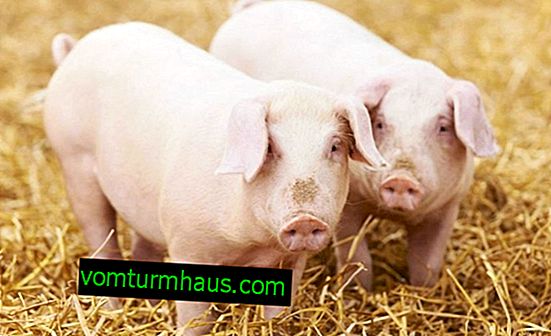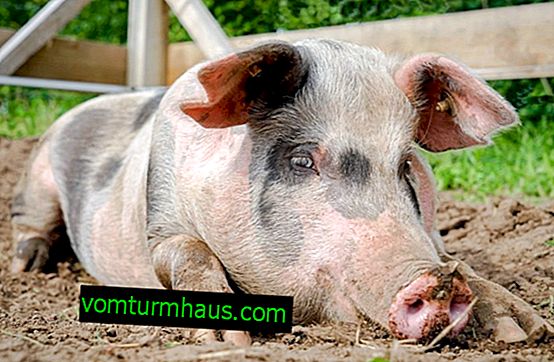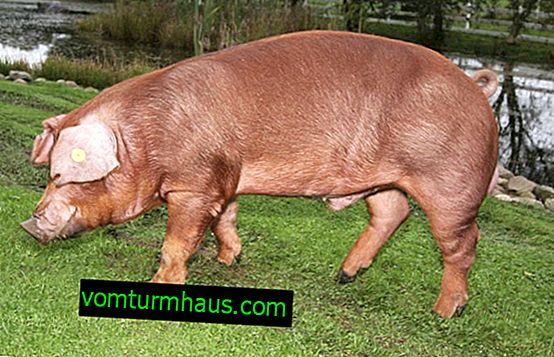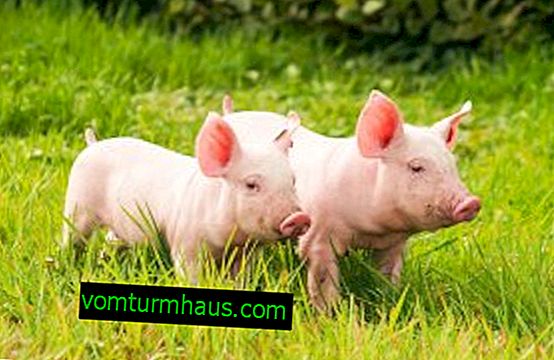Landras - breed of pigs: description, features of keeping and feeding
Representatives of the Landras breed belong to the bacon category of pigs. When slaughtered, they get a large amount of tasty lean meat, and the fatty subcutaneous layer in these animals is very thin. Due to its many positive qualities, Landras pigs are elite breeds. Consider the main characteristics of animals, the rules of their cultivation and feeding, as well as the features of reproduction and possible diseases of pigs.
Appearance story
Landras pig meat was obtained as a result of crossbreeding of the Large White and Danish Fold Pigs in the early twentieth century.

Breed characteristics
Landrace pig is a good source of bacon for large breeders, but has a number of significant drawbacks. Purebred landrases have weak legs that cannot withstand the weight of the trunk, and are very susceptible to disease.
To improve the characteristics of the breed, Landrace thoroughbreds are crossed with pigs of other breeds, such as:
- Large white;

- Breitovskaya;

- Mirgorodskaya;

- Wales
- Duroc.

The most popular bacon pig breeds obtained on the basis of the described breed include:
- Norwegian Landras;
- Estonian bacon;
- French Landrace.
Further in the article - all about the characteristics of the appearance and productivity of purebred Landras pigs, as well as a description of their strengths and weaknesses.
External parameters
Representatives of the breed are distinguished by mobility, despite the large fleshy body. Animals have round hams, and their body looks strong and massive. Pig skin is thin and white, unevenly covered with sparse white bristles. Boars have a longer trunk and weigh more sows.
















Description of the external characteristics of representatives of the Landras breed is presented in the table:
| Dimensions | large |
| Color | white |
| Head | small |
| Ears | large, hanging over the eyes |
| Neck | fat, fleshy |
| Torso | elongated, strong |
| Chest | narrow |
| Stomach | tight, round |
| Back | straight and long |
| Legs | middle length |
| Bristle length | 2-3 cm. |
Weight and dimensions
Piglets of this breed at birth have a weight of 600 to 800 g, depending on the sex of the individual. The weight of young animals depends on the diet and the conditions of the pregnant sow, as well as on the number of piglets born at a time.

Adult Landras boars reach a weight of 280–300 kg. Moreover, their body length is about 2 m, and their chest circumference is 1.5 m. Sows are smaller and have a body length of 1.6 m with a weight of 200–220 kg. Their chest circumference is almost the same as that of wild boars.
Productive qualities
Representatives of the breed have high meat productivity. The net meat yield per adult reaches 70%. At the same time, meat has excellent taste characteristics and belongs to the category of lean. The thickness of the subcutaneous fat does not exceed 2 cm. Important! To achieve high levels of productivity, it is necessary to provide landrace with good living conditions and a nutritious diet. The sows of the breed described are multi-fertile. Young individuals gain weight quickly thanks to accelerated protein synthesis. On average, the weight gain of a piglet per day can reach 750 g. The survival rate of young animals under good conditions and proper feeding is quite high.
Advantages and disadvantages
The Landrace breed has gained popularity in many countries of the world. Due to their high meat productivity, these pigs are raised both on large pig farms and in private households.
- The positive qualities of the Landras breed include:
- fast weight gain;
- a high percentage of slaughter meat;
- a thin layer of subcutaneous fat;
- tasty and lean bacon;
- precocity;
- high fecundity of sows;
- developed maternal instinct;
- good survival of young animals;
- good natured character.
- The minuses of landrace are:
- whimsical content and feeding;
- weak legs and shaky gait;
- low stamina;
- frequent complications during labor in sows;
- tendency to obesity (with improper feeding);
- weak immunity.
How to choose good individuals when buying
Landras piglets are best bought in November or December. Until spring, small representatives of the breed can be kept indoors. In the spring, they need to organize grazing in the pasture and eating fresh herbs, which will favorably affect the speed of weight gain. By the onset of autumn, piglets will grow up and be ready for slaughter.

Here are some suggestions on how to choose a good Landras pig:
- The animal should have a long body and strong stable legs.
- It is necessary to choose active and motile piglets, with a good appetite - these are the main signs of health.
- For good and healthy piglets, a squeal is clean and clear.
- It is better to buy young animals, which have already been vaccinated against common diseases of pigs (plague, leptospirosis, erysipelas).
- The Landrace pig should have pink and supple skin.
- The tail of a healthy individual is always twisted in the form of a spiral - this indicates a good tone of all muscles.
- The eyes of a little pig should be clean, without swelling and discharge.
- The body of the pig should be taut and muscular. This suggests that he digests the food well and is gaining weight normally.
- If you buy a pig to feed and send him to slaughter, it is better to choose a pig, not a boar. Sow meat is tastier and more tender.
- When buying a small pig for further breeding, you need to pay attention to the productive characteristics of her mother.
Features of cultivation and care
Representatives of the breed in question demonstrate high meat productivity only if they are properly maintained and properly cared for. Therefore, you need to take care of arranging a suitable room and adhere to the list of certain requirements for the care of pigs. Equally important for animals and a balanced diet. Let us consider in more detail the features of landrace maintenance.
Conditions of detention
Landrace pigs need comfortable conditions. This factor plays a decisive role for the well-being of animals and the achievement of high meat productivity.

Landrace spend a significant part of the time indoors, which must comply with a specific list of requirements:
- The size of the crib . Representatives of the breed are large, therefore, they need a large amount of free space. These animals cannot be kept in cramped conditions - this will slow down their weight gain and increase the number of diseases in the livestock.
- Clean and dry litter . Landrace needs cleanliness, so you need to monitor the condition of the litter in the stable and change it as it becomes dirty or wet. Wet flooring radiates cold, especially in winter, as a result of which pigs can catch a cold.
- Suitable air temperature . Landras pigs love heat, so the air temperature in the stable should not be below +20 ° C. In winter, animals are kept in well-insulated and heated hangars.
- Draft Protection . Too thin a layer of subcutaneous fat makes the breed very sensitive to drafts. All cracks and holes in the crib must be carefully closed, because on a cold draft Landrace can catch a cold and get sick.
- Humidity level . Pigs of this breed do not tolerate high humidity and can catch a cold. If the room for keeping animals is cold and damp, then you need to install a heater - it will make the air warm and dry.
- Lighting mode . Landrace needs light pens. If there are windows in the stable with pigs, then in the summertime there may be enough natural light. In winter, when daylight hours are short, you need to install lamps for artificial lighting in the room.
Walking organization
Landras pigs like to walk outdoors. In addition, animals need daily physical activity to prevent obesity. The walking area must be carefully fenced off on all sides by a strong fence so that heavy pigs do not break it and do not run away.

In winter, landrace walks are carried out mainly in a stable. If the street is not very cold, then the animals are briefly released into the fresh air. At the same time, care must be taken that they do not become cold, because their body cannot retain heat for a long time.
Feeding at home
Landras pigs require strict adherence to the feeding regimen and the use of only high-quality, nutritious feeds. In order for the animals to gain good weight at the time of slaughter, you need to feed them correctly: these picky and capricious pigs will not eat any food. How to feed adults and young animals - more on this later in the article. You will be interested to read about how to find out the weight of a pig.
Adult pigs
To obtain the highest quality bacon, Landras pigs must have a nutritious and varied diet containing the necessary vitamins and minerals. Particular attention should be paid to the quality of food, buying feed only from trusted manufacturers.
The list of foods and vitamins that Landrace adult pigs should receive is presented below:
- fresh grass (nettle and clover) - a source of carotene;
- nutritious compound feed - contains a full range of vitamins necessary for pigs;
- bran;
- hay and cake;
- silage;
- fresh vegetables;
- fish and bone meal - a source of amino acids;
- mixtures of ground cereals;
- yeast - contain B vitamins;
- dairy products (milk, whey);
- fish oil - contains vitamins A and D;
- chalk - a source of calcium to strengthen the skeleton.
In winter, animals are fed three times a day. For good weight gain, pigs are given a large amount of fresh vegetables and hay. It is especially important to include fresh pumpkin in the pig’s diet.

Landrace banned foods include:
- raw potatoes - causes poisoning;
- whole grain - difficult to digest and causes digestive upsets;
- potato and tomato tops - poisonous to animals;
- stale silo (rotten or moldy).
Young animals
Within one month after birth, the piglets feed on the sows milk. After that they are excommunicated and fed with solid food. It is necessary to introduce new products into the diet of young animals gradually even at the stage of feeding breast milk. At the time of weaning, sows should be able to chew and digest solid food on their own. The diet of young individuals of the breed in question must be balanced so that the piglets gain weight well.

For good growth, piglets need to be given:
- fried cereals (corn, wheat);
- greenery;
- yogurt;
- compound feed;
- grated fresh carrots (give 2 weeks after birth);
- boiled vegetables - beets, potatoes and pumpkin (give 2.5 weeks after birth).
In the summer, a large amount of greenery and garden tops are added to the diet of young animals. Piglets like clover and nettle, which stimulate growth well and contain many vitamins.
In winter, the lack of fresh herbs is offset by an increased portion of fresh and boiled vegetables. Piglets are also given silage, chopping, hay dust.
For well-being and strengthening immunity, Landras pigs need vitamins.
Important! The amount of feed for young animals is calculated by the proportion: 4 feed units per 1 kg of growth.
Therefore, along with complementary foods, the following products are also introduced into the diet of young animals:
- chalk - a source of calcium, strengthens bones;
- fish and bone meal - contains essential amino acids;
- ready-made feed vitamins of groups A and D;
- salt (in small amounts) - stimulates the appetite;
- sod - contains useful minerals.
Young growth should be fed at least three times a day.

Landrace pigs should not be given the following products:
- poor quality feed;
- tops of potatoes and tomatoes;
- bananas and citrus fruits;
- coffee beans and tea leaves.
No less important for piglets and drinking regime. Clean and fresh water with a temperature not lower than +15 ° С must constantly be in the drinkers of pigs. When feeding dry food, piglets need to drink plenty of water to prevent constipation. Read also about the loose-bellied Vietnamese pig.
Pig breeding
Usually pigs Landras bred by experienced breeders, because animals require special conditions for mating and the ability of the owner to properly deliver. But if you strictly follow all the recommendations described below, then you can breed the breed in a small household.
Landras sows are mature at 6 months of age. But to get healthy and numerous offspring, it is better to happen to a pig with a boar at the age of 8-10 months, when its body is sufficiently strong. Did you know? To stimulate the slow labor of the sow, you need to attach newborn piglets to its nipples. They will suck milk, thus stimulating the pig’s contractions.
Signs of the beginning of sexual hunting in sows are:
- constant nervousness and even aggressiveness;
- redness and swelling of the genitals and nipples;
- loss of appetite;
- genital mucous membranes;
- immobility of the sow while pressing her back;
- the sow's emphasis on the front legs when trying to push it forward from behind.
The duration of sexual hunting in pigs is about two days.
A suitable wild boar must be found in advance. The case is carried out immediately after the appearance in the pig of signs of readiness for mating. During the hunt, the boar should cover the sow twice. The first time he is launched to the pig 12 hours after the appearance of signs of hunting, and the second time - another 12 hours after the first mating.

It is not always possible to fertilize a sow the first time. If she started having sex again, then she must repeat the mating, but choose another insemination boar for her.
If, after mating, the pig behaves calmly and does not show signs of sexual hunting during the next three weeks, then mating can be considered successful.
During pregnancy, Landras sows are characterized by the following features:
- curdled discharge from the genitals;
- the sow spends most of the time lying down;
- decreased appetite and lethargy;
- weight gain.
Pregnancy in Landras pigs lasts 114 days from the moment of mating. It’s important to keep track of time so that you don’t miss a birth day. The sow may need help, so the presence of a person is necessary at all stages of farrowing.

The birth of a Landras sow can last several days. The duration of contractions is different, on average, the interval between them is 10 minutes. After each fight, the pig gives birth to one piglet.
Video: farrowing sows
During farrowing, you need to take care of newborn piglets and take the necessary actions in relation to them:
- wipe dry with a soft, clean cloth;
- cut the umbilical cord and treat the wound with iodine;
- place piglets under an incandescent lamp for heating;
- attach piglets to the nipples of the sow for 45 minutes;
- слабых малышей приложить к передним соскам, в которых содержится больше всего молока.
Иногда свинья становится агрессивной после опороса и может случайно раздавить своё потомство или даже съесть его. Чтобы этого не произошло, в дальнейшем поросят помещают в отдельно огороженное пространство рядом с её загоном. Каждые 2–3 часа малышей выпускают к ней для кормления. Для тех поросят, которым не хватило места возле сосков, вводят прикорм молоком из бутылочки, однако нельзя допускать привыкания малыша к ней, чтобы поросёнок в дальнейшем не потерял способности жевать пищу и успешно её переваривать.
Болезни и возможные проблемы
Представители породы Ландрас имеют слабый иммунитет и подвержены различным заболеваниям. Снизить риск их возникновения помогает своевременная вакцинация и различные профилактические действия.

Рассмотрим подробней самые распространённые заболевания ландрасов:
- Сальмонеллёз . Симптомами заболевания являются высокая температура и слабость, диарея, голубовато-красный цвет ушей, ног и живота. Лечение производят антибиотиками, которые назначает ветеринар. Лучшей профилактикой заболевания является вакцинация поросят сразу после рождения.
- Колибактериоз . Признаками заболевания выступают повышение температуры тела, потеря аппетита, диарея и судороги. Лечение комплексное с применением антибактериальных препаратов и пробиотиков. Для профилактики животным делают прививку от колибактериоза на третьи сутки после рождения.
- Лептоспироз . Признаками заболевания являются лихорадка, расстройство пищеварения, аборт в последнем триместре беременности, кровавая моча. Лечение осуществляется антибиотиками. Вакцинация от лептоспироза в возрасте 1, 5 месяцев поможет защитить животных от этой болезни.
- Рожа свиней . К симптомам заболевания относятся истощение животного, нарушения сердечной деятельности, посинение ушей. Лечение животных осуществляют с помощью антибиотиков пенициллиновой группы и противорожистой сыворотки. Для профилактики поросятам делают прививку от рожи в возрасте 2 месяца. It will be useful for you to find out

- Чума . Самая опасная болезнь свиней, которая не поддаётся лечению и почти всегда заканчивается летальным исходом. Симптомами являются расстройства пищеварения, снижение температуры тела, покраснения кожи, гематомы фиолетового цвета. Прививка от чумы делается в возрасте 3 месяца и снижает риск возникновения заболевания до минимума.
- Гельминтоз . Симптомами болезни являются вялость животного, потеря аппетита и снижение веса. В фекалиях свиньи также можно обнаружить гельминтов. Лечение осуществляется медицинскими препаратами, содержащими фенбендазол, ивермектин и левамизол. Для профилактики заболевания нужно следить за чистотой кормушек и поилок животных, проводить регулярную уборку загонов для животных.
- Чесотка . Симптомами заболевания являются сильный зуд, покраснение и сыпь на коже, беспокойное поведение свиньи. Для лечения свинью моют водой с фосфорорганическими соединениями, а кожу смазывают кокосовым маслом. Чтобы предотвратить возникновение заболевания, нужно следить за чистотой в помещении для животных и регулярно менять подстилку.
- Простуда . Заболевшие особи начинают чихать и кашлять, повышается температура, дыхание затруднено. Лечение животных осуществляется антибиотиками. Для профилактики простуды свиней нужно содержать в тепле и устранить все сквозняки. Пол должен быть укрыт плотной и сухой подстилкой.
Иногда у самок ландрасов наблюдается резкое снижение половой активности. При этом не наступает половая охота, а свиноматка становится вялой. Решить эту проблему можно с помощью обогащения пищевого рациона хрюшки. Нужно давать ей больше питательного корма и витаминов, обеспечивать выгул на свежем воздухе. Important! Большинство болезней можно предотвратить, если содержать свиней в чистоте и давать им достаточное количество витаминов.
Breeding prospects
Работа селекционеров над улучшением породы Ландрас продолжается до сегодняшнего дня. Уже изучены многие комбинации скрещивания кабанов Ландрас со свиноматками других пород. Дальнейшие эксперименты по скрещиванию с другими мясными породами позволят получить новые породы выносливых и неприхотливых в содержании свиней с высокими показателями продуктивности, скороспелости и плодовитости.
Видео: порода свиней Ландрас
Чистокровные свиньи Ландрас имеют значительное количество недостатков и привередливы в уходе. Но при выполнении рекомендаций по их содержанию и кормлению с этих животных можно получить многочисленное потомство и большое количество вкусного и качественного бекона.








